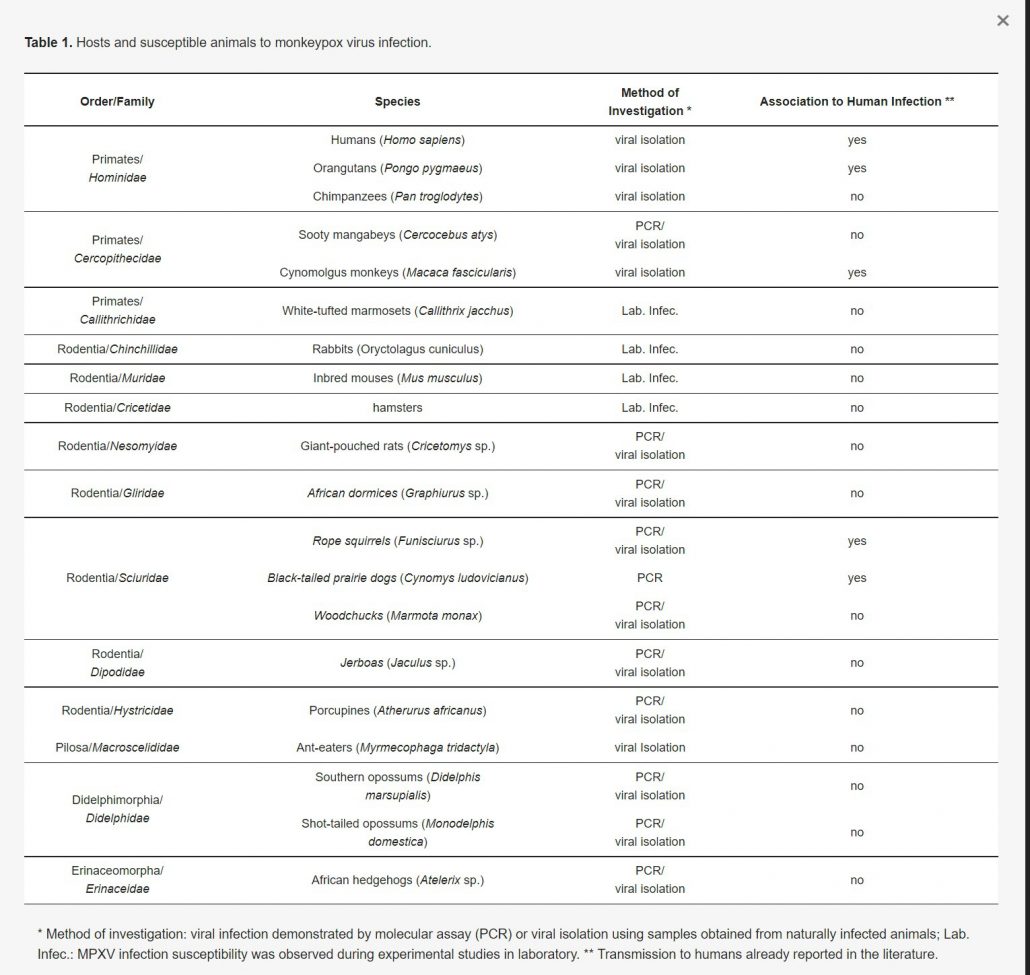Mpox in animals
Mpox in animals
Published 6 June 2022 | updated 5 June 2025
Mpox (monkeypox) is considered to be a zoonosis and various species have been identified as susceptible to the virus with rodents considered the natural reservoirs of infection. Mpox has not been detected in animals in the UK. However, the UK Health Security Agency (UKHSA) on behalf of the joint Human Animal Infections and Risk Surveillance (HAIRS) group, has published a risk assessment.
Qualitative assessment of the risk to the UK human population of monkeypox infection in a canine, feline, mustelid, lagomorph or rodent UK pet. [UK Health Security Agency] [online]. Available from: https://www.gov.uk/government/publications/hairs-risk-assessment-monkeypox/qualitative-assessment-of-the-risk-to-the-uk-human-population-of-monkeypox-infection-in-a-canine-feline-mustelid-lagomorph-or-rodent-uk-pet [accessed 1/6/2022]
This document recommends that susceptible mammalian pets, that were in direct close contact with an infected human, should be isolated for a period equivalent to the human maximum incubation period of 21 days. Veterinary management of animal patients involves symptomatic treatment and supportive care, as required.
It should be noted that susceptibility of animals, including white rats, rabbits, golden hamsters, and guinea pigs, appears to depend on the route of inoculation and age / immune status of the animal.
There has now been a single reported case of human-to-dog transmission of Mpox:
Seang, S. et al. (2022) Evidence of human-to-dog transmission of monkeypox virus. The Lancet, https://doi.org/10.1016/S0140-6736(22)01487-8
Further details of the evidence relating to the susceptibility of different species can be found in the following published papers.
- MacNeill, A.L. et. al. (2025) Poxvirus pathology and pathogenesis in agriculturally important species. Veterinary Pathology. https://doi.org/10.1177/03009858251338854
- Morgan, C.N. et al. (2024) One health investigation into Mpox and pets, United States. Emerging Infectious Diseases, 30 (10), pp.2025-2032. https://doi.org/10.3201/eid3010.240632
- One Health investigation into Mpox and pets, United States. Emerging Infectious Diseases, 30 (10). https://wwwnc.cdc.gov/eid/article/30/10/24-0632_article
- Hutson, C.L. and Damon, I.K. (2010) Monkeypox virus infections in small animal models for evaluation of anti-poxvirus agents. Viruses, 2 (12), pp. 2763-2776. https://doi.org/10.3390/v2122763
- Parker, S. and Buller, R.M. (2013) A review of experimental and natural infections of animals with monkeypox virus between 1958 and 2012. Future Virology, 8 (2), pp. 129-157. https://doi.org/10.2217%2Ffvl.12.130
- Mucker, E.M. et al (2015) Susceptibility of marmosets (Callithrix jacchus) to monkeypox virus: a low dose prospective model for monkeypox and smallpox disease. PLoS ONE, 10 (7), https://doi.org/10.1371/journal.pone.0131742
- Silva, N.I.O. et al (2020) Here, there, and everywhere: the wide host range and geographic distribution of zoonotic orthopoxviruses. Viruses, 13 (1), p.43. https://doi.org/10.3390/v13010043
This paper includes the following table:

[Reproduced under Creative Common CC BY license from: Silva, N.I.O. et al. (2020) Here, there, and everywhere: the wide host range and geographic distribution of zoonotic orthopoxviruses. Viruses, 13 (1), p.43. https://doi.org/10.3390/v13010043]
- The World Organisation for Animal Health (OIE) have also produced a list of questions and answers on moneypox and animals.
Questions and answers on moneypox and animals. [World Organisation for Animal Health] [online]. Available from: https://www.woah.org/en/disease/monkeypox/ [accessed 6 June 2022]
- Factsheet: Monkeypox (2020). [Center for Food Security and Public Health] [online]. Available from: https://www.cfsph.iastate.edu/Factsheets/pdfs/monkeypox.pdf [Accessed 27 June 2022]

Leave a Reply
Want to join the discussion?Feel free to contribute!